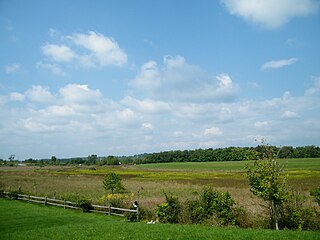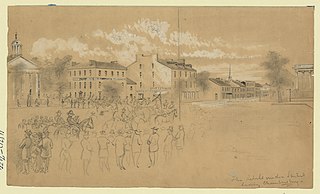
The Battle of Monocacy was fought on July 9, 1864, about 6 miles (9.7 km) from Frederick, Maryland, as part of the Valley Campaigns of 1864 during the American Civil War. Confederate forces under Lt. Gen. Jubal A. Early defeated Union forces under Maj. Gen. Lew Wallace. The battle was part of Early's raid through the Shenandoah Valley and into Maryland in an attempt to divert Union forces from their siege of Gen. Robert E. Lee's army at Petersburg, Virginia.

The Battle of Cloyd's Mountain occurred in Pulaski County, Virginia, on May 9, 1864, during the American Civil War. The fight has also been called the Battle of Cloyd's Farm. A Union Army division led by Brigadier General George Crook defeated a Confederate Army consisting of three regiments, one battalion, and Confederate Home Guard. The Confederate force was led by Brigadier General Albert G. Jenkins and Colonel John McCausland. Although the intense fighting portion of this battle may have lasted for only one hour, it was southwestern Virginia's largest fight of the Civil War.

The Second Battle of Kernstown was fought on July 24, 1864, at Kernstown, Virginia, outside Winchester, Virginia, as part of the Valley Campaigns of 1864 in the American Civil War. The Confederate Army of the Valley under Lt. Gen. Jubal A. Early soundly defeated the Union Army of West Virginia under Brig. Gen. George Crook and drove it from the Shenandoah Valley back over the Potomac River into Maryland. As a result, Early was able to launch the Confederacy's last major raid into northern Union territory, attacking the Baltimore and Ohio Railroad in Maryland and West Virginia and burning Chambersburg, Pennsylvania, in retaliation for the burning of civilian houses and farms earlier in the campaign.

The Valley campaigns of 1864 began as operations initiated by Union Lieutenant General Ulysses S. Grant and resulting battles that took place in the Shenandoah Valley of Virginia during the American Civil War from May to October 1864. Some military historians divide this period into three separate campaigns. This article considers them together, as the campaigns interacted and built upon one another.

The Battle of Moorefield was a cavalry battle in the American Civil War, which took place on August 7, 1864. The fighting occurred along the South Branch of the Potomac River, north of Moorefield, West Virginia, in Hardy County. The National Park Service groups this battle with Early's Washington Raid and operations against the B&O Railroad, and it was the last major battle in the region before General Philip Sheridan took command of Union troops in the Shenandoah Valley. This Union triumph was the third of three major victories for Brigadier General William W. Averell, who performed best when operating on his own.
The town of Romney, Virginia, traded hands between the Union Army and Confederate States Army no fewer than 10 times during the American Civil War, assuming the occupying force spent at least one night in the town. The story of the small town is emblematic of the many military campaigns that swept through western Virginia and, later, the new state of West Virginia.

John McCausland, Jr. was a brigadier general in the Confederate army, famous for the ransom of Hagerstown, Maryland, and the razing of Chambersburg, Pennsylvania, during the American Civil War.
The Army of the Valley was the name given to the army of Lt. Gen. Jubal Early's independent command during the Shenandoah Valley Campaigns in the summer and autumn of 1864. The Army of the Valley was the last Confederate unit to invade Northern territory, reaching the outskirts of Washington, D.C. The Army became defunct after its decisive defeat at the Battle of Waynesboro, Virginia, on March 2, 1865.
The Battle of Fairfield was a cavalry engagement during the Gettysburg Campaign of the American Civil War. It was fought July 3, 1863, near Fairfield, Pennsylvania, concurrently with the Battle of Gettysburg, although it was not a formal part of that battle. While a minor fight by the small number of troops deployed, strategically, the Confederate victory secured the important Hagerstown Road, which Robert E. Lee's Army of Northern Virginia would use on July 5 to return to Maryland and then on to safety in Virginia.
Loudoun County, Virginia, was destined to be an area of significant military activity during the American Civil War. Located on Virginia's northern frontier, the Potomac River, Loudoun County became a borderland after Virginia's secession from the Union in early 1861. Loudoun County's numerous Potomac bridges, ferries and fords made it an ideal location for the Union and Confederate armies to cross into and out of Virginia. Likewise, the county's several gaps in the Blue Ridge Mountains that connected the Piedmont to the Shenandoah Valley and Winchester were of considerable strategic importance. The opposing armies would traverse the county several times throughout the war leading to several small battles, most notably the Battle of Ball's Bluff.

The 1st West Virginia Cavalry Regiment served in the Union Army during the American Civil War. Although it started slowly, it became one of the most active and effective of the West Virginia Civil War regiments—and had 14 Medal of Honor recipients, the most for any West Virginia regiment during the war. It was originally called the 1st Virginia Cavalry, not to be confused with the Confederate 1st Virginia Cavalry. Some reports added "Union," "Loyal" or "West" when identifying this regiment. After the Unionist state of West Virginia was officially admitted to the Union in 1863, the regiment became the 1st West Virginia Cavalry Regiment. The National Park Service identifies it as the 1st Regiment, West Virginia Cavalry.

Evitts Creek is a tributary stream of the North Branch Potomac River in the U.S. states of Pennsylvania and Maryland. The confluence of Evitts Creek and the North Branch Potomac River is located 2 miles (3 km) east of Cumberland, Maryland.

McNeill's Rangers was an independent Confederate military force commissioned under the Partisan Ranger Act (1862) by the Confederate Congress during the American Civil War. The 210 man unit was formed from Company E of the 18th Virginia Cavalry and the First Virginia Partisan Rangers. After the repeal of the Act on February 17, 1864, McNeill's Rangers was one of two partisan forces allowed to continue operation, the other being 43rd Battalion Virginia Cavalry. Both of these guerrilla forces operated in the western counties of Virginia and West Virginia. The Rangers were known to exercise military discipline when conducting raids. However, many Union generals considered Captain John Hanson McNeill (1815–1864) and his men to be "bushwhackers," not entitled to protection when captured, as was the case with other prisoners of war.
The Romney Expedition was a military expedition of the Confederate States Army during the early part of the American Civil War. It is named for Romney, West Virginia, which at the time was still in the state of Virginia. The expedition was conducted in this locale from January 1 to January 24, 1862, as part of the preliminary actions of Stonewall Jackson's Valley Campaign. Confederate forces under Major General Thomas J. "Stonewall" Jackson cleared Union forces under Major General Nathaniel Banks and Brigadier General William S. Rosecrans from the lower Shenandoah Valley and surrounding Allegheny ranges, and then successfully severed the Baltimore and Ohio Railroad and the Chesapeake and Ohio Canal.

Folck's Mill is a site containing the remains of a historic grist and saw complex located near Cumberland, Allegany County, Maryland. The stone foundation of the mill, measuring 30 feet by 40 feet, is the principal feature of the site. It is historically significant for its association with the August 1, 1864, Civil War "Battle of Folck's Mill." In that battle, Union troops commanded by General Benjamin F. Kelley engaged General John McCausland’s Confederate forces as they advanced along the Baltimore Pike towards Cumberland after having burned the town of Chambersburg, Pennsylvania, two days previously.

The Raid on Chambersburg, often identified as J.E.B. Stuart's Chambersburg Raid, was a Confederate States Army cavalry raid into Maryland and Pennsylvania on October 10–12, 1862 during the American Civil War. It became known as Stuart's "second ride around McClellan" because it duplicated Stuart's reconnaissance ride completely around the Union Army of the Potomac under Major General George B. McClellan during the ill-fated Peninsula Campaign.
Lieutenant John R. McNulty of Baltimore, Maryland was a Confederate soldier. During the Battle of Old Town, his 2nd Maryland Artillery prevented an element of the Army of Northern Virginia led by Brigadier General John McCausland from being trapped behind Union lines. At the time, the unit was returning from raids into Maryland and Pennsylvania, where they had sacked and burned Chambersburg, Pennsylvania. After the civil war, he served as a presidential elector for James A. Garfield in 1881.
The Battle of Old Town was a U.S. Civil War battle fought on August 2, 1864 as part of the Valley Campaign of 1864. Union forces amassed and took high ground at Oldtown, Maryland on the Potomac River in an attempt to trap Brigadier John McCausland’s Confederate States Army raiders behind Union lines.
The 2nd Maryland Infantry, Potomac Home Brigade was an infantry regiment that served in the Union Army during the American Civil War.

The 14th Pennsylvania Cavalry Regiment was a cavalry regiment of the Union Army during the American Civil War. Most of its fighting happened in the last half of 1863 and full year 1864. The regiment fought mainly in West Virginia and Virginia, often as part of a brigade or division commanded by Brigadier General William W. Averell and later Brigadier General William Powell.












